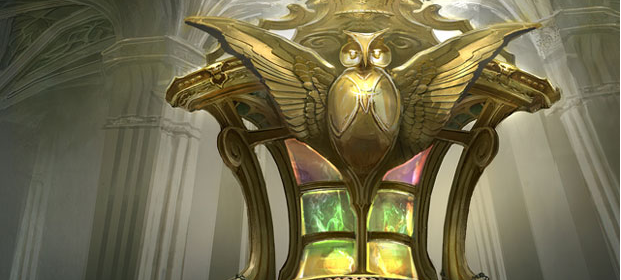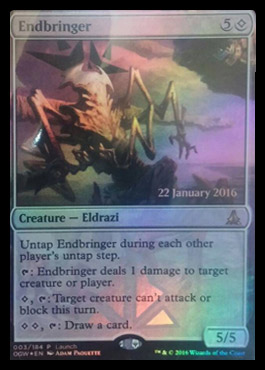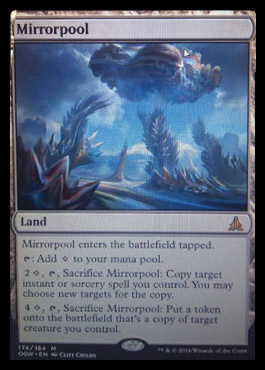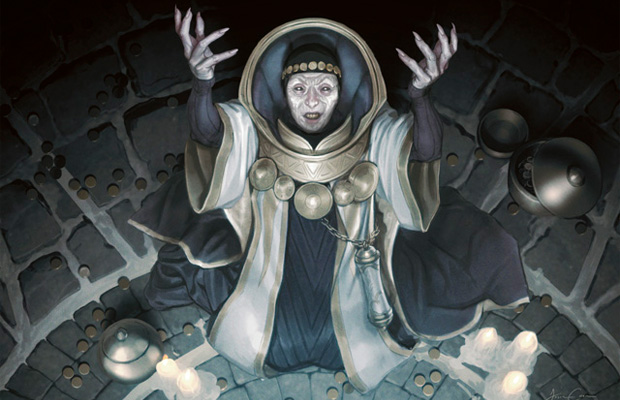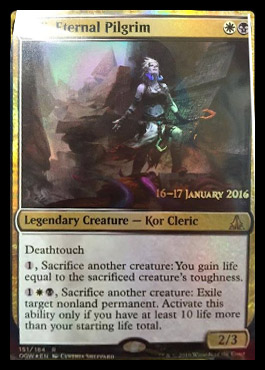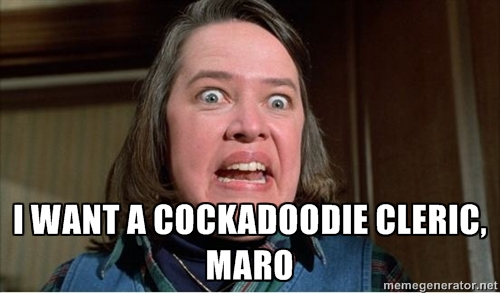It’s a new year and there are new cards and everything old is new again, but that doesn’t mean some new things aren’t just old things. The good thing about old things is that they behave predictably. Predictability is moneymakeability sometimes.
New cards are like rocks for the purpose of this upcoming metaphor and the sense that new cards and rocks are both “things,” I guess. People who spend a lot of time thinking about “traditional” MTG finance are very good at scrutinizing rocks. They take measurements, write articles about how many uses the rock has and whether people are going to take other rocks out of their… 60-rock collections (this metaphor is breaking down much faster than I thought it was going to) to make room for the new rocks and generally focus too much on the rock. The rock doesn’t matter, probably. I mean, it matters, but not in the way you might think.
Why the Rock Itself Doesn’t Matter
You may recognize this picture from our Oath of the Gatewatch spoiler coverage, and I am going to keep posting it because I think it’s very important. This is a list of all of the cards in Battle for Zendikar that are worth more than $2 retail. This is it. Fifteen cards. Coming in a hair over $2 is Omnath, Locus of Rage. How can that be? This card is EDH gold. Have you seen this card?
Look at this card.
Look at it.
Look at it.
This is a card that is going to cause people to run right out and build a deck around him. He’s a pretty good-looking rock. So why shouldn’t we spend too much time thinking about him?
It’s pretty simple, really.
Buying this for at its reasonable-seeming $6 preorder price turned out to be an excellent way to nutpunch yourself to the tune of $4 a copy plus shipping and handling. It turns out sometimes it doesn’t matter how good a card looks and how obvious it is that the card is going to launch an archetype.
What Are Rocks Good For?
I’m glad I pretended you asked that. While everyone else is studying the rocks and pontificating about how reasonable a $6 presale price is in the short term, I’m throwing rocks into ponds and checking out the ripples they make. The money’s all in ripples.
Sometimes, a big enough rock can raise the water level in the pond a little bit, which I am going to assume translates to a lot of cards going up in price. Like Nekusar made a ton of related cards go up while doing nothing financially himself, Omnath has a chance to impact lots of other cards that go in a deck with him at the helm or in the 99 somewhere. Landfall is a cool mechanic, and landfall enablers could see a bump in those colors. Elemental cards like Elemental Mastery have upside now. Every ripple in the pond is an opportunity for a much older card to go up in price, even as the rock sinks to the bottom of the pond and ends up only worth a buck or two.
So why am I bringing this up?
The Next Big Rock

This card is probably the most important card in Oath of the Gatewatch in terms of EDH, and this card is going to be a bulk rare for a while. This is a concept that took me a while to adjust to. I was used to Standard and Modern and Legacy finance, where a good card was a good card and then people gave monies for it at the cards store and then everyone high-fived. It’s taken some getting used to, but I am learning that even though cards like this sometimes don’t really make a financial impact, they can make stuff happen with other cards. What makes me so sure that Eldrazi Displacer won’t be worth money if it’s as good as I say it is? Let’s look at a different kind of card.
What is a Staple?
A good commander like Omnath can be the centerpiece of an EDH deck that causes the cards that go in that deck to go up in price, and that’s cool. It’s also a little bit narrow. While a good card with a solid foundation that you can build upon (brought that rock metaphor right back around. You thought I couldn’t do it and I showed you. I showed both of us.) is certainly good for the cards that can go in that deck, what do we do in a block where we don’t get a bunch of juicy legendary creatures with sicko abilities and relevant tribal affiliations? Do we wait for the annual Commander sealed decks for innovation to happen, or do we look at some other cards that can do things financially? I vote we look a little harder and identify a different kind of card that can also matter.
My series has focused mostly on “rocks” since I started writing it, and that’s cool because we have identified a lot of really saucy cards and made a lot of money on cards that seem like obvious targets. Still, while we were focusing on new, splashy, obvious stuff, cards we didn’t really focus on because we took them for granted just kept going nuts.
A staple is a card that’s considered an auto-include in a wide array of decks. Sol Ring is a staple. Command Tower is a staple. Yes, Chromatic Lantern is a staple, also. Staples work a little differently, price-wise. Since they are used in a wider array of decks, their price is a little less capricious and tied to the whims of individual cards. The health of the format as a whole is the metric that puts pressure on prices, not individual commanders being printed (or banned, I guess).
Which is Eldrazi Displacer and what makes us think we can predict its price?
I think Eldrazi Displacer may be a bit of both and a bit of neither.
Not All Staples Are Created Equal
Staples are an odd thing. Sometimes prices don’t make much sense given how overwhelmingly good one card can seem versus another card with more supply and a much higher price. It’s pretty clear that not all staples are created equal, and while some cards may have more power narrowly, broad utility seems to carry the day. We have nothing but examples of this, and we have a chance to play with EDHREC a little more to see if we can figure out some patterns.
Some cards shrug off a reprinting and continue to climb seemingly no matter what happens. These are cards that are needed in most decks that can run them, nearly irrespective of the specific commander. These cards are going to be safe-ish but unsexy ways to ensure incremental growth until a second reprint sneaks into your house, drenches your life savings in kerosense, and flicks a lit cigarette at the pile while it walks away in slow motion without even turning around to look at the fire. Cyclonic Rift is very good in EDH in a lot of decks, and is sure to get you punched in your throat if you Overload it two games in a row.
Cards like this aren’t always super sexy, but they’re worth knowing about, and they’re worth stocking. If you buy some of these at buylist and jam them in a binder, they will be good trade bait and there is no reason to hurry to get rid of them since they’ll grow at a steady rate. There’s some reprint risk, but if there were no risk in MTG finance, no one wouldn’t do it.
There are cards that seem like they’re staples because of how well they interact with a lot of decks but which don’t necessarily span the format like a card like Temple of the False God does. Food Chain makes mana way more efficiently than Temple and it enablers some explosive strategies, but it’s also narrow compared to Temple. It’s important to know how wide a card appeals when we start throwing around the word “staple.”
Gilder Bairn is worth a surprising (to some) amount of money and it’s a great enabler in a lot of different strategies. Solid cards like this are worth knowing about, worth stocking, worth playing, and worth watching, but they don’t quite have the reach. This can still be called a “staple,” I guess, and I’m not sure we want to say there is a cutoff point where a card this good becomes too narrow to be considered one, especially since we lack a metric other than price to compare the two. Or do we?
Apples to Oranges
Playing around on EDHREC, I realized there is a way to judge a card and develop a mathematical (or at least numerical) basis for comparing the degree to which a card is considered a staple in EDH. EDHREC does something very useful when you search for individual cards.
Do you see it?
Numbers! We can look at numbers to see how often a card is played and use that to judge how broadly it appeals. The more broadly a card appeals, the more likely its price is to rise, because more decks push it up and the overall health of the format (growing in popularity daily) can expose the card to upside. A narrower card has less upside even if it’s more powerful. Sol Ring is in 25,839 of the 37,091 decks that can play it, a percentage of 69.66. That seems a little lower than I had expected, but what can you do? A percentage this high shows its appeal is broad, but is also a decent harbinger of reprint risk. With annual Commander decks on the horizon, reprint risk is worth knowing about.
A percentage of 51.23 for this card.
And 46.60 percent for Cyclonic Rift. Almost half of the decks running blue on EDH Rec run a utility card. It’s no wonder the card is trending up in price. Reprints slowed its growth down for a time, but this is really impacting the format. I think a percentage around 40 to 50 is very good and indicates the card is a staple for the format, not just for particular decks. Did I expect the number that I wanted to see to be a bit higher than 50 percent? Yes, but Command Tower isn’t much higher than that and there isn’t much point in not playing Command Tower in decks that are more than one color. They’re $1. Get you some. If Command Tower is played in 51 percent of eligible decks, than Cyclonic Rift’s 46.6 percent is pretty phenomenal.
I think checking the percentage is a good metric and I am going to use it in my analytical toolbox from now on.
Is There a Card to Compare Eldrazi Displacer To?
Yep. And you all know what it is already.
Deadeye Navigator is a lot like Eldrazi Displacer, and it’s $1. While we have no idea to what extent Eldrazi Displacer is going to get adopted when it’s printed, if we find a corollary like Deadeye Navigator, we can analyze the card by proxy a little bit. What can our new metric tell us about what percentage of decks we can expect to jam Eldrazi Displacer?
We’re coming in at about 15-percent adoption for the Navigator.
Power level is important. It’s very important. It tells us whether a card is worth bothering with. It tells us the likelihood that the card is worth removing a card in the deck already to make room. It tells us whether it can launch an archetype or support one well enough to make that archetype more worth playing. But Cyclonic Rift is five times as expensive as Deadeye Navigator because it’s in three times as many blue decks. Some other factors matter, also, such as the butt-puckering fear that Deadeye will be banned basically every ban cycle, but for the most part, the extent to which a card is played across the format seems to be what matters most.
I feel like we can expect to see Eldrazi Displacer in about 15 percent (plus or minus five percent) or so of EDH decks. It’s likely to be redundant to Deadeye Navigator and in a lot of the same decks. It’s also going to give decks that run white but not blue access to these shenanigans, but since decks that are blue but not white can run Deadeye already, and since blue is played more in EDH than white, I imagine that’s a wash. If Eldrazi Displacer doesn’t get some help from other formats, it’s likely going to end up a $1 card just like Deadeye Navigator. There is a bit of good news, though.
Foils of Deadeye are almost $9. I expect the foil multiplier on Eldrazi Displacer to be much lower for about a year, so you have a while to snag as many foil copies as you can before they jump.
I have a lot more I want to say on this topic, but I’ve exceeded my word count. Why not turn this into a two-parter? Next week, we can look at how a card like Eldraiz Displacer being destined to be in roughly 15 percent of the decks in the format can be a little deceiving. When can a staple act like a rock? Find out next week. Until then!

















